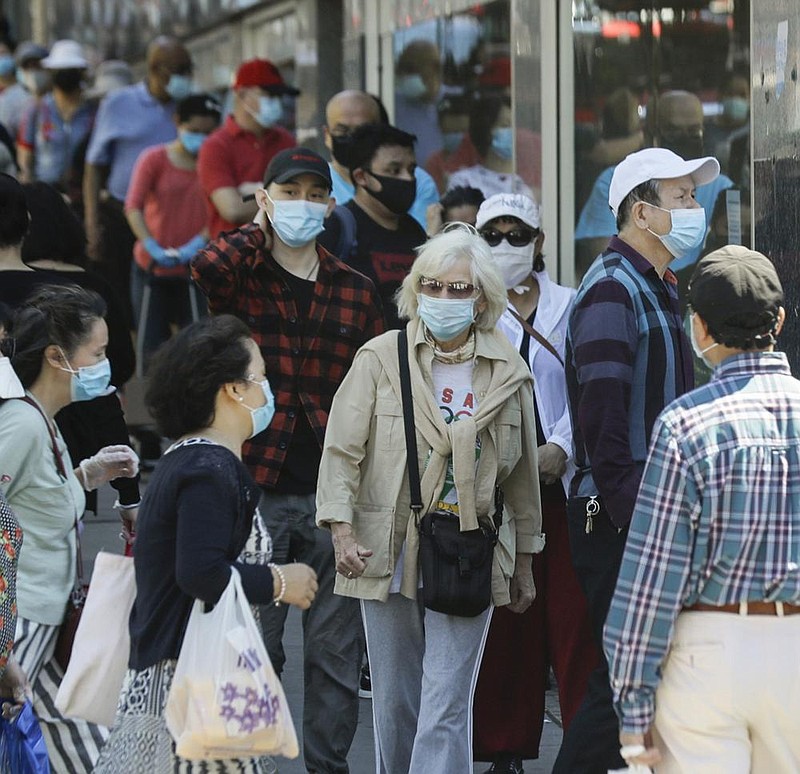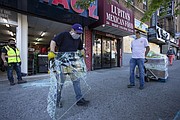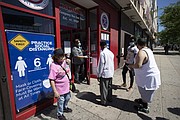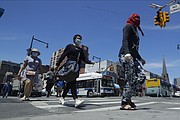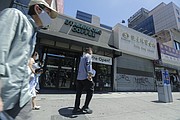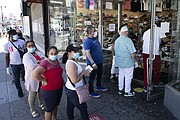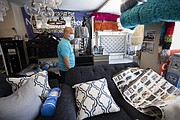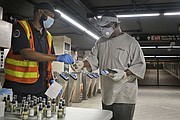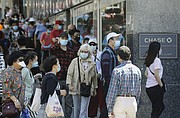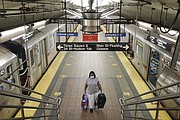NEW YORK -- Scarred by the deadliest coronavirus outbreak in the nation, New York City gradually began reopening Monday in a turning point in the three-month-long crisis and a test of the city's discipline.
With the virus in check -- at least for now -- stores previously deemed nonessential were cleared to reopen for delivery and curbside pickup, though customers cannot yet browse inside. Construction companies, manufacturers and wholesalers also were cleared to resume work.
"So far, so good," construction management company owner Frank Sciame said as job sites started humming again, with new precautions such as health screening questionnaires and lower limits on the number of workers allowed in construction hoists. "Let's hope it continues."
[Video not showing up above? Click here to watch » https://www.youtube.com/watch?v=pAKF2um8pzI]
"New York," he said, "will always come back."
Some major store chains took it slow: Macy's declined to give a date for starting curbside pickup at its flagship store, where smash-and-grab thieves hit during last week's protests over George Floyd's death. Saks Fifth Avenue, which girded itself with razor wire last week, and Tiffany's may launch pickup service later this week.
Owners of smaller shops were eager to reopen, even if they didn't expect much business.
"We are going to be open every day for the sake of showing life," said eyewear designer Ahlem Manai-Platt, who was reopening a lower Manhattan store.
Mayor Bill de Blasio welcomed the reopenings as evidence of how "strong and resilient" New York is. But he also warned the city against letting its guard down and jeopardizing its hard-won progress against the virus. "Let's hold onto it. Let's build on it," he said.
Unrest over racism and police brutality could compound the challenges facing the nation's biggest city as it tries to move past three bleak months. Officials who had focused for months on public health and economic woes are now also facing urgent pressure for changes in policing.
More than 21,000 deaths in New York City have been attributed to covid-19, or roughly 1 in 5 of the more than 110,000 people who have died of the disease in the U.S.
At its peak, the coronavirus killed more than 500 people a day in New York City in early to mid-April. The number has since dropped into the single digits. New hospitalizations, which topped 800 a day in late March and early April, were down to 67 on Saturday.
Reopening the economy could spark a resurgence of the virus as people circulate more.
"All eyes will be on New York this next couple of months," said urban policy expert Jonathan Bowles, executive director of the Center for an Urban Future. "The city now has to prove that it really knows what it's doing, that it can still be a dense city like New York and yet figure this out."
[CORONAVIRUS: Click here for our complete coverage » arkansasonline.com/coronavirus]
Sam Solomon wondered what normal will look like from now on.
"I don't know if it's ever going to be like it was," said Solomon, 22, who has a health-related job. After months of relative isolation, "it's going to be an adjustment being around so many people," said the native New Yorker, who said she never thought she would have to get used to crowds.
Around the world, the coronavirus has killed more than 400,000 people, with the toll rising by thousands every day. The virus is still raging in places like Brazil, which over the weekend stopped reporting its death toll. Its official count stood at more than 36,000, giving it the third-highest number of dead in the world, behind the U.S. and Britain.
New York City, population 8.3 million, had already reawakened somewhat as warm weather drew people outdoors, as more restaurants offered carryout service, and as thousands of people marched in protest over Floyd's death at the hands of Minneapolis police.
[Gallery not loading above? Click here for more photos » arkansasonline.com/69newyork/]
Subway ridership is ticking back up after plunging from 5.4 million rides per weekday in February to under 450,000 in April, the city's transit agency said. Subway schedules are returning to normal, though workers are dispensing masks and hand sanitizer, signs show riders how far apart to stand on platforms, and the 1 to 5 a.m. shutdowns that began in May will continue so trains can be cleaned.
Gov. Andrew Cuomo took a subway ride Monday to send a message of safety.
Many activities, such as indoor dining and gym workouts, aren't yet allowed. Broadway theaters and other big venues remain shuttered. And New Yorkers are still required to wear masks when close to others in public.
Months of social distancing and mask-wearing have made New Yorkers better prepared to keep the coronavirus under control, said Dr. Bruce Polsky, chairman of medicine at NYU Winthrop Hospital in suburban Mineola.
Still, he said, reopening is "going to be a big test."
SHUTDOWNS' EFFECTS
Also on Monday, a study published by researchers at the University of California, Berkeley that examined how stay-at-home orders and other restrictions limited the spread of the contagion concluded that shutdown orders prevented about 60 million coronavirus infections in the United States and 285 million in China.
A separate study from epidemiologists at Imperial College London estimated the shutdowns saved about 3.1 million lives in 11 European countries, including 500,000 in the United Kingdom, and dropped infection rates by an average of 82%, sufficient to drive the contagion well below epidemic levels.
The two reports, published simultaneously Monday in the journal Nature, used completely different methods to reach similar conclusions. They suggest that the aggressive and unprecedented shutdowns, which caused widespread economic disruptions and job losses, were effective at halting the exponential spread of the novel coronavirus.
"Without these policies employed, we would have lived through a very different April and May," said Solomon Hsiang, director of the Global Policy Laboratory at the University of California, Berkeley, and the leader of the research team that surveyed how six countries -- China, the United States, France, Italy, Iran and South Korea -- responded to the pandemic.
His team estimated that, in the initial days after the virus was seeded in each country, and before the shutdowns, the number of infections was doubling every two days.
"The disease was spreading at a really extraordinary rate that is rare even among very infectious diseases," he said in an interview. The global response to covid-19, the disease caused by the virus, resulted in "saving more lives in a shorter period of time than ever before," he said in a separate conference call with reporters.
The two reports on the effectiveness of the shutdowns come with a clear warning that the pandemic, even if in retreat in some of the places that were hardest-hit, is far from over. The overwhelming majority of people remain susceptible to the virus. Only about 3% to 4% of people in the countries that were studied have been infected to date, said Samir Bhatt, senior author of the Imperial College London study.
"This is just the beginning of the epidemic: we're very far from herd immunity," Bhatt said Monday in an email. "The risk of a second wave happening if all interventions and precautions are abandoned is very real."
Information for this article was contributed by Jennifer Peltz, Carla K. Johnson, Anne D'Innocenzio, Karen Matthews and Brian Mahoney of The Associated Press; and by Joel Achenbach and Laura Meckler of The Washington Post.

